Natives vs. exotics. We’ve heard that before haven’t we Bert? Well, here’s an interesting little nugget published recently in the journal Ecology Letters. Exotics and natives are different, and their differences allow them to coexist. In this study exotics were superior to natives in terms of growth, but were fed upon more by herbivores. Interesting. Of course there are lots of different types of exotics and natives, but the plants that these researchers looked at had been living together for about 200 years. I think that’s something that the invasive extremists and apologists consistently forget – until relatively recently the average person didn’t spend that much time thinking about native or exotic, and yet the world never turned into a desert and neither the natives nor the exotics disappeared. I’m not saying we shouldn’t think about native vs. exotic differences at all, just that sometimes we concentrate on this distinction too much. Plants tend to be able to fend for themselves.
Month: November 2012
Ornamental Peppers for the Holidays (!)
Growers and garden centers are always on the lookout for Poinsettia alternatives. Points make up the vast majority of potted flowering plants sold this time of year, but other crops are gaining ground. Due in part to the popularity of All-American Selection (AAS) winner ‘Black Pearl,’ there’s been an explosion of ornamental pepper varieties. Most are pretty versatile – can be used as bedding plant, in containers, and as a potted flowering plant. Edible? Depends on your threshold for pain.
I took these photos during an August visit to the immense trial gardens of Rakers (Litchfield MI). They had at least 30 varieties of ornamental pepper, and many look very similar. Hopefully I’ve got these labeled correctly…
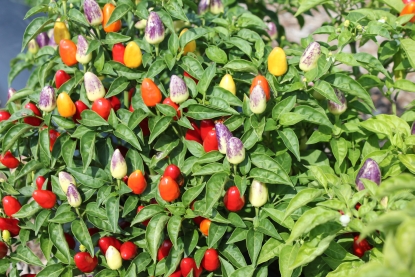
‘NuMex Twilight’, bred by the folks at the Chile Pepper Institute at New Mexico State, has been around for a while. There were lots of look-alike cultivars in the trial. But they all resemble Christmas lights!
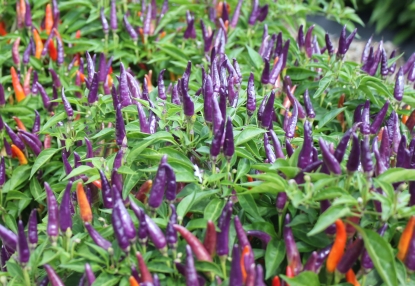
‘Sangria’ peppers start purple then ripen bright red.
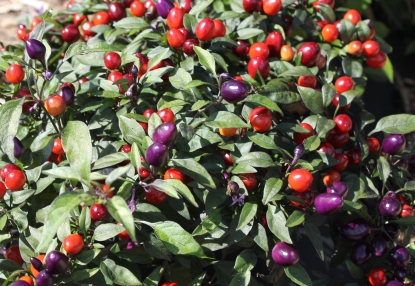
I believe this one is ‘Pretty in Purple.’
I think any of these would be very gift-able for the holidays. Dressed up with a nice 5" clay pot and a raffia bow…would you buy an ornamental pepper for decor or a gift?
A holiday gift idea
In deference to the holiday season, I’ll step down temporarily from my soapbox and mention a great holiday gift idea for your favorite gardener.
I saw this sedum stump a few years ago when I was speaking to a Master Gardener group in British Columbia. The porous nature of the stump would make it easy for the roots of the sedums and other rock-garden types of plants to establish. And the stump could be easily moved to wherever the recipient desired.

This isn’t just a warm climate idea, either. There are a number of sedum species that are cold hardy and as long as the stump was well protected in the winter, the roots would be fine.
Why oh Why? Christmas tree edition
Hope everyone has had a chance to digest their Thanksgiving meal and is spending a productive day at work shopping on-line. My daughter and I enjoyed one of our Holiday traditions this weekend and brought home a Christmas tree from a local choose-and-cut farm. This was followed by another tradition at our house known as the “Annual cursing of the Christmas lights.” Seems like no matter how careful I am when I put away the lights when we take down the tree, they are always a mangled mess the next year.
Christmastime is also time for another ‘Why oh why?’ As in, why do people make such a big deal out of watering their tree? Working in Extension with Christmas trees, I’m glad that we’ve gotten the word out and people are concerned with keeping their tree watered. But is it really that hard to put water in the stand? I use a watering can with a long stem and it seems to work fine. Let’s look at some of the devices people have come up with water Christmas trees. I’ve rated each on scale of 0 to 4 watering cans.

The tree IV. I’ve mentioned this one on the blog before. The theory here is that the tree will suck up water from a reservoir you attach to the trunk. Trunk injection is possible with conifers but requires pressure and resin quickly fills the hole. 0 cans.

The watering cane. OK, maybe you’ve got back problems and bending over with a regular watering can could be an issue. 4 cans.
Water funnel system. I’m not sure the video convinced me this is faster and easier than the watering can. 2 cans.

Water reservoir cleverly disguised as a package. Assuming the issue is you don’t like to bend over and put water in the stand, I don’t see where bending over to put water in a fake package is a big improvement. And what happens if you forget which package is which? 2 cans.
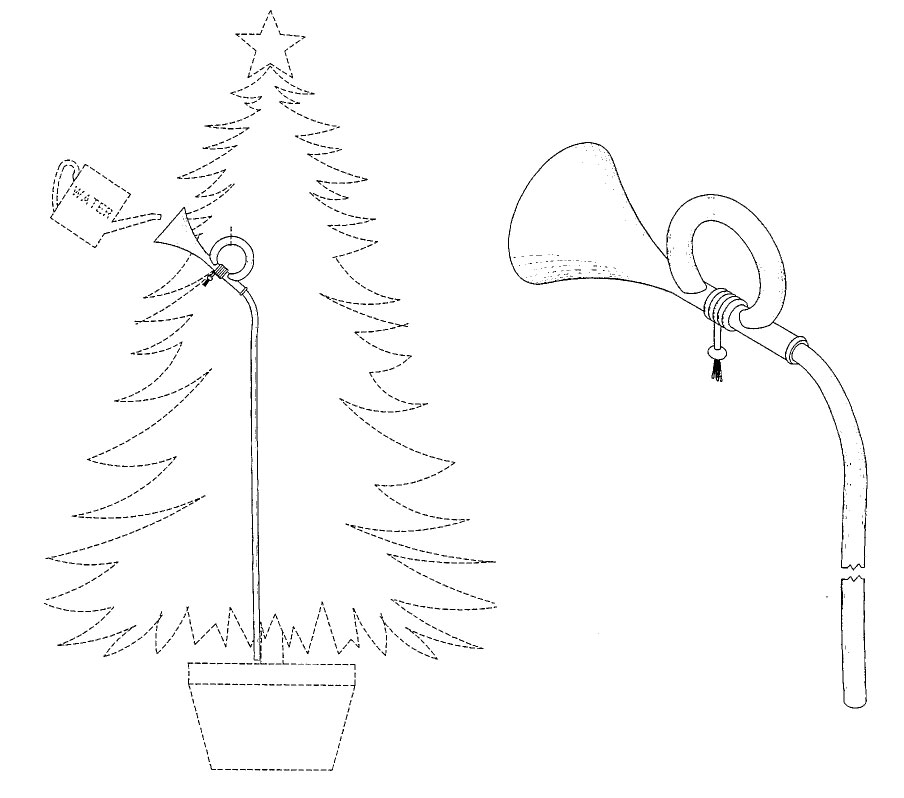
Funnel cleverly disguised as an ornament. Gets around the bending over issue, but can you really hide the tubing? 3 cans.
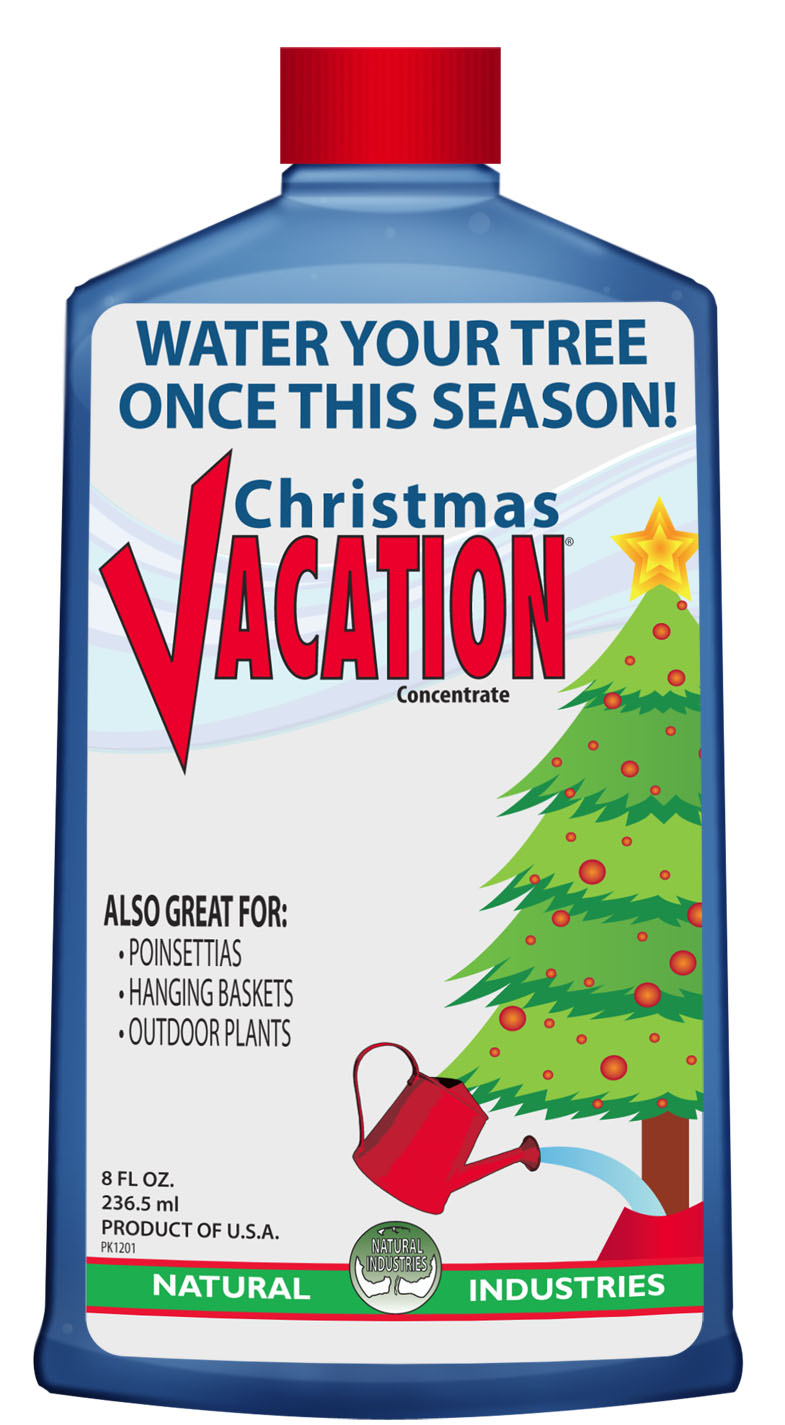
Christmas Vacation anti-transpirant. According to the advertisement you can put this stuff in the first time you water the tree and then you are good to go for the next month. The same product is sold as ‘Stasis’ and is used to protect bedding plants from wilting during shipping. The theory is that the product induces stomatal closure by increasing abscisic acid levels. I’m withholding judgment on this one until I see some data one way or the other, but to say I’m dubious is an understatement.
Keeping a Christmas tree hydrated is like most things; you can’t go wrong with the tried and true. A fresh tree that is kept well-watered will retain needles for weeks and is very unlikely to be involved in a tree fire. A tree this is allowed to dry, on other hand, is another story. So before depending on a gimmick to keep your tree watered ask yourself if you’re willing to bet your house on it.
Thanksgiving
Yesterday was the day before Thanksgiving. In my plant production class I always set up a short lab for Wednesday afternoon so that students can leave early and get to wherever they need to go (hopefully to see family). As usual, I got to lab a little early so that I could get the students going right away. Waiting for me there was one of my students.
Earlier in the year I had told the class about commercial mycorrhizae and how the beneficial spores that you think you’re buying are usually dead when you purchase the package. Well, this student wanted to check it out, so, unbeknownst to me, he purchased some mycorrhizae and placed them into a petri dish with a special nutrient mix to grow these fungi (he works in a lab which has this kind of material available). He came to lab early to tell me about his results.
As a teacher it’s easy to get discouraged in a classroom. Sometimes it’s tough to tell whether the students are listening and I wonder if I’m getting through. But then a student goes and does something like this and it’s all worth it.
The results of his little test don’t really matter (though they did confirm what I’d told the class), what matters is that the student heard what I’d said and went to the trouble to test it for himself.
So this Thanksgiving I’m thankful that I’m fortunate enough to witness and take some small role in the intellectual curiosity of students.
Happy Thanksgiving Everyone!
PS: Just so everyone knows, The Garden Professors are becoming much more active on Facebook. Just search for The Garden Professors and Like us!
Research that gardeners should appreciate!
Today I received my November 2012 issue of Arboriculture and Urban Forestry. This is one of the few peer-reviewed journals that generally has information of immediate value to gardeners and landscape professionals as well as academics. This issue contains an article entitled “Evaluation of biostimulants to control Guignardia leaf blotch (Guignardia aesculi) of horsechestnut and black spot (Diplocarpon rosae) of roses.” (And before you ask, no, I can’t attach the article or link to it. You’ll need to read it in the journal itself or wait for a year when the organization makes it available to everyone.)
Anyway, this study looked at eight different self-identified biostimulants, including Superthirve (which every gardener must have heard of by now). In addition to Superthrive, the other products tested were Maxicrop Original, Resistim, Bioplex, Fulcrum CRV, Redicrop, Crop Set, and Systhane. Purported active ingredients within this group include seaweed extract, molasses, vitamin B, and Lactobacillus fermentation product.
And the $64,000 question – did they work? Here’s the authors’ summary: “Irrespective of pathogen or concentration applied, none of the biostimulants used in this investigation provided a significant degree of Guignardia leaf blotch or black spot control compared to water-treated controls.” In other words, you can expect the same results by spraying your black spot-infested roses with water compared to any of these biostimulant products.
The authors end their article with a caveat sure to warm the cockles of every Garden Professor’s heart: “Results of this study indicate that where independent scientific data are not available to support the pathogen control claims of the manufacturer, then using an unevaluated biostimulant for this purpose is not recommended.”
(I’m glad this article is finally out. I was one of the peer reviewers for it, and I’ve been wanting to share the results on the blog ever since I read it.)
What would YOU do?
Once in a while we end up flicking around the dial on Friday evenings and land on a show called “What would you do?” It’s a hidden camera-type set up where viewers get to see the reaction of everyday folks faced with awkward or contentious situations like an overbearing customer berating a waitress over a minor mistake in their bill. The scenarios are played out by actors but the people responding are not. Personally I find the premise of the show slightly annoying because it smacks of entrapment but it seems to lure in the rest of my family.
Today we’ll do our own version of “What would you do?” In this case, however, the situation is real. Here’s the deal. Michigan State University has begun work to complete the Facility for Rare Isotope Beams or FRIB across the street from the Horticulture building. This $615 million dollar project will enable physicists to study rare nucleotides, the kind of elements that only exist for fractions of seconds. It’s definitely big science stuff and can lead to all kinds of exciting discoveries. In looking at some of the plans for the FRIB, however, some of my colleagues discovered that the FRIB completion will require removal of several large mature oak trees that close to 100 years old. The initial effort to save the oaks focused on re-locating the portion of the FRIB that conflicted: No dice. The next option was to move the oaks. Due to various factors, only one tree, a bur oak about 3 feet in diameter, can be moved. The price tag: approx. $150,000. The move date is currently set for Dec. 10. Now another option has surfaced: remove the mature oak and use the $150k to plant new trees around campus. Our landscape services typically plants 2” caliper shade trees and 6’-7’ conifers so we’re probably talking 400-500 trees. I am part of a group that will try to hash things out on Wednesday.
So, what would YOU do? Save one large mature tree or plant 400+ new?
Here’s a look at the oaks through the years…

Today. Oaks trees are located in median in center of the image.

1980 during construction of the Wharton Center for Performing Arts

1965

1955
A Note To Horse Owners
Every once in awhile I get to work with really, really cool people who do really, really cool work. This is one of those times. About a year ago I received a message from Dr. Stephanie Valberg, a Professor over at the University of Minnesota’s Equine Center. It seems that she was interested in looking at a deadly disease called Seasonal Pasture Myopathy which she thought might have something to do with horses ingesting maple leaves. Specifically, at the time she contacted me, she thought that this disease might be associated with horses ingesting tar spot, a common disease that maples get. Seasonal Pasture Myopathy is a particularly nasty disease because it is fatal in over 90% of cases, and the death is far from painless.
After doing site visits to many farms where this disease was found, she discovered something very important: Every farm had box elders in a location where horses could feed on the seed when they got hungry. And for most of the farms, horses were also dealing with scant pickings in terms of food. They usually had sparse pastures and not much supplemental hay. So, in these conditions, the horses might find box elder seed attractive, or at least palatable.
After a literature search, Dr. Valberg discovered an old article showing that box elder seeds could very well contain a toxin, hypoglycin A, which might cause this disease if they were eaten. After testing the seeds for the presence of this toxin (Done by a friend of mine, Adrian Hegeman, located here in the University of Minnesota’s Department of Horticultural Science) it was established that, Yep, box elder seeds have this toxin, and if your horse eats them, it might be in trouble. You can find out more here.
Right now more work is going on to see if this toxin is more or less present in box elder trees that are under stress, if it is present in other parts of the tree besides the seeds, and at what time of year the toxin might be most present in the seeds. It also looks as though some other maples may have this toxin in their seeds, most notably sycamore maple.
All in all, having the opportunity to watch this work unfold has been one of the highlights of my career. It was like watching an episode of House unfold in real life. And the great part is that this work has the potential to save the lives of dozens, if not hundreds or thousands, of animals. So if you have horses, and box elder or sycamore maples in your pasture, be careful!
Cold Weather Discussion
Next Monday Nov. 19th, we’re going to have a google+ discussion (that means digital cameras) on getting ready for cold weather. It will be scheduled for 2:00 Central, 3:00 Eastern, 1:00 Mountain, and 12:00 Pacific. It will be Linda, Myself, and a few other people. If you have any interest in participating, or any burning questions, please drop me a line at gillm003@umn.edu. We’d like to get three or four people from cold climates on with us!
Yes, this will be on YouTube a few hours after the discussion occurs.
Important, must-read announcement regarding pesticide use
There’s a new report out from the Weed Science Society of America (WSSA) which blasts a common piece of gardening advice: use least toxic pesticides only as a last resort. Popular as it may be, this advice is not scientifically grounded and can actually cause more harm than good. The WSSA is joined in this announcement by the American Phytopathological Society (APS) and the Plant-Insect Ecosystems Section of the Entomological Society of
America (P-IE ESA).
This is a must-read for anyone who is a responsible educator regarding pesticide use, which includes Master Gardeners and other horticulture paraprofessionals. You’ll want to use the webpage link above to read the entire announcement, but here’s a paragraph to get you thinking:
“There is no benefit or scientific basis to simplistic messages like “use least toxic pesticides as a last resort” for the large number of pesticide users who apply pesticides according to the label and practice good stewardship. Nor are these messages beneficial for those who neither seek training nor adequately read the label believing instead that it is safe, practical, and effective to simply choose a product considered a “least toxic pesticide” and apply it only as a “last resort.” These messages hinder pesticide safety and stewardship education and practices that are in the best interest of the pesticide user, our food supply, public health and ecosystem preservation.”